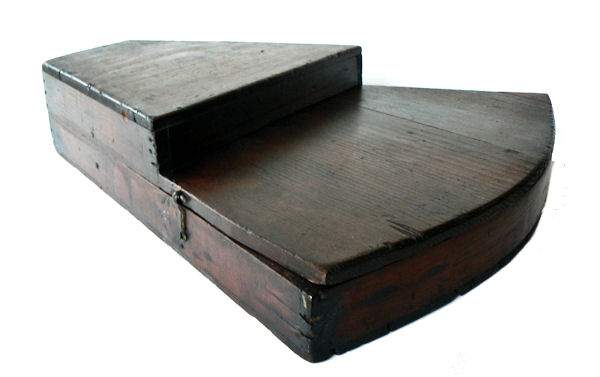THREE MIRROR BACK
SIGHT EARLY HADLEY STYLE OCTANT

Presented is a very large octant with an index arm of 16 inches
made by the famous British instrument maker, Spencer, Browning & Rust of London. It is only one inch smaller than Hadley’s
“double reflecting” octant which was submitted to the Royal Society in London in 1731. Shortly thereafter,
Hadley began selling octants with a vertical dimension of 17 inches compared to this instruments 16 inches. We can conclude
that SBR was one of the first to adopt the Double Reflecting principal in their own instruments.
Housed in a keystone, stair step case of the periodIt has the characteristics
of a very early octant consisting of:
- An early style Ebony frame
- Three mirrors
- Two peep sights
- Maker’s name on cross member
- Ivory pencil holder and ivory tab on back
- Flat brass index arm 16 inches or longer
- Graduated arc from – 5 degrees to + 100 degrees
- Vernier reading from right to left, 0 to 20 minutes
- Precisely machined bronze fittings
- Single set of three movable shades (filters)
The three shade glass assembly is movable for placement at either the index mirror position or below at
the secondary position where the third mirror allows for the taking of “back sights”.The precise spacing and
markings on the arc suggest that this instrument was made by a superior instrument maker, standing at the top of
his trade. In our opinion, it is the equal in quality of any instrument of this early period.
MARKINGS: In addition to the cross
member having the maker’s name, at the center of the ivory degree’s scale, between 45 and 50 degrees, is inscribed in
script “SBR” identifying this instrument as that of Spencer, Browning & Rust, of London.
piece
& Co. after the death of Ebenezer Rust. The successor, Spencer Browning had offices at a number of addresses
on Wapping High Street, London and were in business until 1870. They had
an early dividing machine and inscribed arcs for others. Ref: Gloria Clifton, Directory of British Scientific
Instrument Makers 1550-1851 (London, 1995), p. 261.
The
metal fittings are precisely machined, which makes this instrument a work of manufacturing excellence for this
early a period.DIMENSIONS:
DATING THE INSTRUMENT: The arc measures from – 5 to plus 95 degrees
on a Ebony frame which is in excellent condition. It is known that Mahogany went out of use in favor of Ebony some time
after 1750. The octant has a flat brass index arm measuring 16 inches long with a finger clamp. Tangent
screws began replacing finger clamps in the last quarter of the 18th Century. The
horizon mirror is mounted on an adjustable turntable. Its base can be rotated by loosening a screw which locks the mirror’s
position. A third mirror is below it for taking back sights and is also adjustable. The ivory vernier scale, reads from
right to left from 20 to 0 arc minutes, a two hole peep sight with “flap”, and movable three sun shades which serve both mirrors
on the frame.
All of these features date the instrument after 1750 and before
1780, likely Ca 1775. Some time after 1780, the index arm clamp was superseded by an adjustable tangent screw, which also
helps date this octant. See Peter Ifland’s comprehensive sextant work, “Taking the Stars”.
particularly figure 64, page 57.
condition except for some minor faults. The front machinery of the octant was polished some time ago and has since
developed some age patina. On the back, some of the machinery is polished and some isn’t. The graduated arc is excellent,
and all the hardware are present. All three bronze legs are original. It has the ivory pad on back, and
the original small ivory scribe. The three mirrors all have remnants of silvering, but show their age.
The Case is the typical stair step
of this period. We believe it not to be original to this octant being made of Pine rarther than Mahogany. The corks are recent
replacements. The top has a long age crack in the lower panel and some chips are missing along the front edge. It
also is slightly warped and does not register exactly when closed. The bottom has a smaller age crack and shows normal signs
of age. Otherwise it is strong and sturdy, and the octant fits as it should. There is no lock, but there two period hooks
and eyes.
Period style stair step case. Note the age crack to the right
All in all, a rare, desirable, and special example of an early
Hadley style octant by England’s early largest instrument maker.
OUR QUALIFICATIONS: We are one of the few company’s still selling
navigation instruments that know anything about them. For purposes of judging whether Joel’s opinion counts, he
was the editor of the chapter on sextants of the 1977 Edition of “Bowditch”, The American Practical Navigator, NAVPUB 9; a
member of the U.S. Naval Academy Navigation Symposium Board, 1975 -1978; the author of a book on marine sextants, Cornell
Maritime Press,1975, and the founding president of Nautech Maritime Corporation which partnered with Tamaya of Japan in the
introduction of the MS 733 Spica, the MS 833, Jupiter, MS 933 Venus sextants and the famous NC-2 navigation computer, in the
U.S. market. Joel is also a retired Master Mariner, and held a U.S. Navy “D” Qualification as a Senior Skipper – Oceans. From 1995 through 2000, he served as a Varsity Offshore Sailing Team coach at the U.S. Naval Academy.








